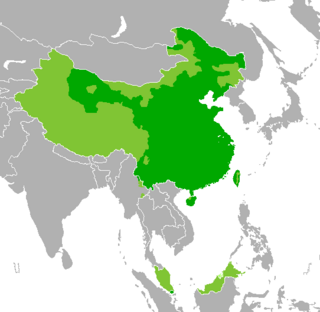Chinese language
Group of languages of the ethnic Han Chinese / From Wikipedia, the free encyclopedia
Dear Wikiwand AI, let's keep it short by simply answering these key questions:
Can you list the top facts and stats about Chinese language?
Summarize this article for a 10 years old
Chinese[lower-alpha 3] (中文; Zhōngwén,[lower-alpha 4] especially when referring to written Chinese) is a group of languages[n 1] spoken natively by the ethnic Han Chinese majority and many minority ethnic groups in Greater China. About 1.3 billion people (or approximately 16% of the world's population) speak a variety of Chinese as their first language.[2]
| Chinese | |
|---|---|
| 汉语/漢語, Hànyǔ or 中文, Zhōngwén | |
 Hànyǔ written in Traditional (top) and Simplified characters (middle); Zhōngwén (bottom) | |
| Native to | China, Taiwan, Singapore and other locations in the Sinophone world |
Native speakers | 1.35 billion (2022)[1] |
Sino-Tibetan
| |
Early forms | |
Standard forms |
|
| Dialects | |
| Chinese characters (Traditional/Simplified) Transcriptions: Zhuyin Pinyin (Latin) Xiao'erjing (Arabic) Dungan (Cyrillic) Chinese Braille ʼPhags-pa script (Historical) | |
| Official status | |
Official language in | |
| Regulated by | Ministry of Education (in the reserved name of "National Commission on Language and Script Work [zh]") (Mainland China) National Languages Committee (Taiwan) Civil Service Bureau (Hong Kong) Education and Youth Affairs Bureau (Macau) Chinese Language Standardisation Council (Malaysia) Promote Mandarin Council (Singapore) |
| Language codes | |
| ISO 639-1 | zh |
| ISO 639-2 | chi (B) zho (T) |
| ISO 639-3 | zho – inclusive codeIndividual codes: cdo – Eastern Mincjy – Jinyucmn – Mandarincpx – Pu-Xian Minczh – Huizhouczo – Central Mingan – Ganhak – Hakkahsn – Xiangmnp – Northern Minnan – Southern Minwuu – Wuyue – Yuecsp – Southern Pinghuacnp – Northern Pinghuaoch – Old Chineseltc – Late Middle Chineselzh – Classical Chinese |
| Glottolog | sini1245 |
| Linguasphere | 79-AAA |
 Map of the Chinese-speaking world
Regions with a native Chinese-speaking majority.
Regions where Chinese is not native but an official or educational language.
Regions with significant Chinese-speaking minorities. | |
| This article contains IPA phonetic symbols. Without proper rendering support, you may see question marks, boxes, or other symbols instead of Unicode characters. For an introductory guide on IPA symbols, see Help:IPA. | |
Chinese languages form the Sinitic branch of the Sino-Tibetan languages family. The spoken varieties of Chinese are usually considered by native speakers to be dialects of a single language. However, their lack of mutual intelligibility means they are sometimes considered to be separate languages in a family.[lower-alpha 5] Investigation of the historical relationships among the varieties of Chinese is ongoing. Currently, most classifications posit 7 to 13 main regional groups based on phonetic developments from Middle Chinese, of which the most spoken by far is Mandarin (with about 800 million speakers, or 66%), followed by Min (75 million, e.g. Southern Min), Wu (74 million, e.g. Shanghainese), and Yue (68 million, e.g. Cantonese).[4] These branches are unintelligible to each other, and many of their subgroups are unintelligible with the other varieties within the same branch (e.g. Southern Min). There are, however, transitional areas where varieties from different branches share enough features for some limited intelligibility, including New Xiang with Southwestern Mandarin, Xuanzhou Wu Chinese with Lower Yangtze Mandarin, Jin with Central Plains Mandarin and certain divergent dialects of Hakka with Gan (though these are unintelligible with mainstream Hakka). All varieties of Chinese are tonal to at least some degree, and are largely analytic.
The earliest Chinese written records are Shang dynasty-era oracle bone inscriptions, which can be dated to 1250 BCE. The phonetic categories of Old Chinese can be reconstructed from the rhymes of ancient poetry. During the Northern and Southern dynasties period, Middle Chinese went through several sound changes and split into several varieties following prolonged geographic and political separation. Qieyun, a rime dictionary, recorded a compromise between the pronunciations of different regions. The royal courts of the Ming and early Qing dynasties operated using a koiné language (Guanhua) based on Nanjing dialect of Lower Yangtze Mandarin.
Standard Chinese (Standard Mandarin), based on the Beijing dialect of Mandarin, was adopted in the 1930s and is now an official language of both the People's Republic of China and the Republic of China (Taiwan), one of the four official languages of Singapore, and one of the six official languages of the United Nations. The written form, using the logograms known as Chinese characters, is shared by literate speakers of mutually unintelligible dialects. Since the 1950s, Simplified Chinese characters have been promoted for use by the government of the People's Republic of China, while Singapore officially adopted simplified characters in 1976. Traditional characters remain in use in Taiwan, Hong Kong, Macau, and other countries with significant overseas Chinese speaking communities such as Malaysia (where, although simplified characters were adopted as the de facto standard in the 1980s, Traditional characters remain in widespread use).